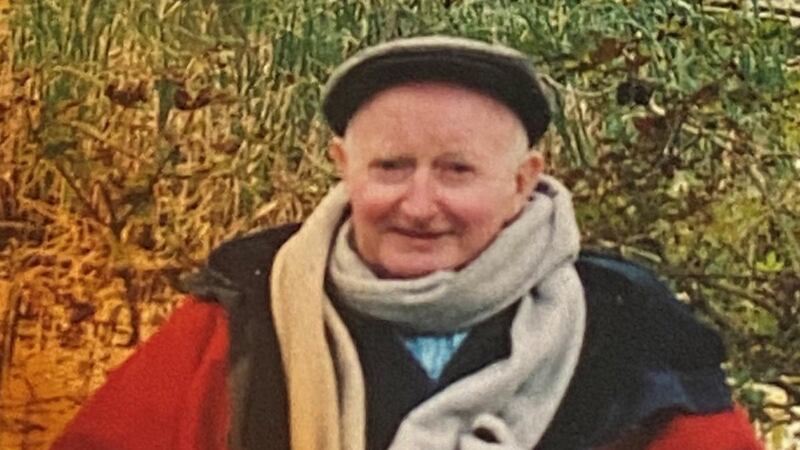The Covid-19 pandemic was at its height last April when film-maker Liam O’Neill went in to hospital for tests for a heart issue and was kept in for observation. In little over a week, while still waiting for an angiogram, he had tested positive for the disease.
Within days, his condition deteriorated, and he required intubation. He was placed on a ventilator, but his kidneys failed. He died on May 29th.
“That was the last time I saw him as Liam, as he was going in to hospital,” his partner Annabel Konig recalls. “After that, he wore his mask all the time. He spent his last three weeks on a ventilator, even his birthday. It was horrible.”

Annabel’s grief at losing her 64-year-old partner is compounded by her belief, “beyond a shadow of doubt”, that he contacted the virus in hospital in Kilkenny.
“He was clear, he didn’t have it going in. I didn’t have it, neither did anybody that we knew,” she says. “It wasn’t as if we were going around hugging anybody. We were being super careful. We live in the middle of nowhere, mountains around us and the nearest village is five miles away.”
*****
It is impossible to say with absolute certainty where anyone picks up a virus as small and transmissible as Covid-19. Was it that person who coughed on the bus? Or that salt cellar passed by a friend who later tested positive?
But it is clear large numbers of people in Ireland contracted the virus in a hospital, the one place where they should have felt safest, and that many of these people have died.
While the loss of life in nursing homes – where thousands of people contracted the virus and hundreds died at their place of residence – has been widely debated, comparatively little attention has been paid to the amount of hospital-acquired infection that occurred during this pandemic.
On the day Liam O'Neill was being buried, The Irish Times revealed official figures showing more than 200 people had contracted the disease in hospital while being treated for other conditions. That number has since risen to 265, and 79 people have died, according to the HSE.
Eight per cent of inpatients picked up the virus in hospital, compared with between 10 per cent and 20 per cent in England, where calls have been made for a thorough investigation of the issue.
Frontline workers have been hit hard in this crisis, with more than 8,200 healthcare staff testing positive. This figure includes infections from all sources – including in the community or from travel – but 745 are related to hospital outbreaks. Fifty cases are categorised as having been acquired from a patient.
As with the Sars epidemic 20 years ago, hospitals emerged as a major carrier for Covid-19. In Italy, the province of Lombardy suffered massive deaths compared with neighbouring Veneto, partly due to a greater rate of hospitalisation.
*****
From talking to families who have lost loved ones in Ireland due to hospital-acquired infection, it is clear many have been left with questions. Could anything have been done to prevent the infection? Why were they not moved out of hospital, if this was possible? Why were they moved around between wards and even hospitals? Why have they heard so little from the system since?

“Once he had contracted it he didn’t stand a chance,” says Julie McNamara of her 83-year-old father Martin, who died in April after a stay in Naas General Hospital.
Martin, from Clane, Co Kildare, had been sent from his nursing home to Naas, where was admitted for the second time in a month after being diagnosed with a urinary tract infection.
It was the height of the pandemic, when hundreds of new cases were being recorded every day. “He was placed on a ward with six other patients at varying stages of illness. Some were coughing and one was within hours of death,” Julie recalls.
“There were staff everywhere, doing their best, but it was shocking.”
Because of Martin's underlying conditions, she knew he wouldn't have the strength to survive the virus. He died on April 14th.
Three months on, she believes “nobody is to blame” for his probable hospital-acquired Covid-19. “It wasn’t a dignified way to go, and it would have been better if it had happened in his room in the nursing home.”
Communications with the hospital were difficult at a time when the only visits allowed were final ones to dying relatives. “You’d have to ring, ring, ring the hospital phone. It would ring out, and then you’d start again.”
“I would have liked to have known more,” she reflects. “I never did find out whether he had been tested when he was admitted to hospital.”
He felt it was dangerous and he just wanted to get out. But the form given him by the doctor basically said 'you're on your own' if you leave.
Peter* says his wife, who had battled cancer for 18 months, contracted Covid-19 after being admitted to hospital for a serious but unrelated infection. “She was admitted to hospital via the emergency department, where she was screened for the virus and tested negative. She underwent treatment for the underlying condition but contracted Covid-19 and died alone after a nightmare week in an isolation ward.
“I personally observed the absence of distancing and other basic protocols among medical staff at all levels throughout the hospital when I was allowed an ‘end of life’ visit. My family and I are distraught at the needless death of a loved one.”
Peter says that former chief medical officer Tony Holohan repeatedly urged the public not to hesitate to attend hospital if they became seriously ill with a non-Covid-19 condition.
In early May, Dr Holohan needed to attend St James’s Hospital himself and was startled to find it empty. Later, he expressed his concern that people might be ignoring symptoms.
“It is a job for the hospital and the job for your GP to ensure you don’t pick up the virus . . . We do not want people staying away when they need to be seen to.”
Based on his experience, though, Peter maintains hospitals were not safe places. Yet people such as his wife, with a life-threatening condition, had little option but to “take the risk” of entering them.
Concerns have emerged over possible crossover of Covid and non-Covid services at Mayo General Hospital and in other care settings.
Peter also asks: “Is there to be any expression of regret from authorities, or is hospital-acquired infection considered merely ‘collateral damage’ in the overall scale of things?”
*****
Konig says her partner didn’t want to wait in hospital for his test but was told he would go “to the bottom of the list” if he checked out.
“He was there for four days, feeling so vulnerable. He felt it was dangerous and he just wanted to get out. But the form given him by the doctor basically said ‘you’re on your own’ if you leave.”
Could Liam not have been sent home and told to self-isolate while awaiting his test, she asks. And why were so few staff wearing protective gear at the time?
The amount of communication from the hospital while her partner was there and after he died, is another source of frustration for Konig. “No one ever contacted me from the hospital. Apart from the doctor I was dealing with, there was no liaison person.
“I would be the one to contact them while Liam was there, for updates, or for medical information, which I’d then have to research. But I’m not a doctor; I’m an artist.”
Ireland East Hospital Group, which includes St Luke’s in Kilkenny, said it cannot comment on individual cases as it has an ethical and legal requirement to maintain confidentiality.
A spokeswoman said its hospitals had a “robust” complaints process and invited families with specific issues to contact a hospital patient liaison officer.
*****
It may never be known exactly how many patients picked up the virus in hospital. Under the definition used by public health officials, a patient has to be at least seven days in hospital before their infection with the virus is automatically regarded as hospital-acquired.
Where the infection arises sooner after admission, the connection with Covid-19 is made only “if epidemiologically linked to hospital exposure”. Effectively, this means the patient is regarded as having picked up the virus in hospital only if they were in close contact with a known case among patients or staff.
Yet in my own family, to take one example, a relative tested positive only after being discharged from hospital (where she was moved five times). Two other family members who were cocooning at home then contracted the disease, and one died. This case would not be captured by the current way of measuring hospital-acquired infection.
Not everyone who lost a loved one to hospital-acquired Covid-19 has concerns. “I get how this disease can hit people, but I’m not into a bitter blame game,” says Sheila*, whose 94-year-old mother Mary* died early on in the pandemic. “When people come to process their own grief, they may find part of it was anger.”
Mary entered a Dublin hospital in February after a health episode and was subsequently transferred to stepdown care. Although she stayed only one night in hospital, she was coughing two days later and died soon after.
“My mother was never sick in her life and we always thought she would die of old age. But she could have had a worse demise, having been minded in a caring environment with good nursing,” Sheila says.
“If you can catch this virus in a supermarket or a petrol station, of you course you can get it in a hospital. I have no anger or blame, but I understand how other people might.”
Lawyers specialising in medical negligence say they are being approached by clients unhappy with the way loved ones died in hospital during the pandemic. The State Claims Agency says it has had no claims to date associated with contracting Covid-19.
Asked whether the extent of hospital-acquired infection during the pandemic should be formally investigated, acting chief medical officer Dr Ronan Glynn says it should be remembered "we are talking about a very infectious disease".
“While it’s not acceptable for one person to get a hospital-acquired infection, the reality is that infectious diseases are transmissible and despite the best efforts of everyone in a pandemic there will always be cases.”
The passage of time has not dimmed Konig’s belief that her partner’s death “shouldn’t have happened”.
“It’s so unfair. This virus robs us of so much but most of all Liam. Okay, he was 64 but that’s a lot of life he had left and a lot of plans we had.”
*Some names changed at the request of families










